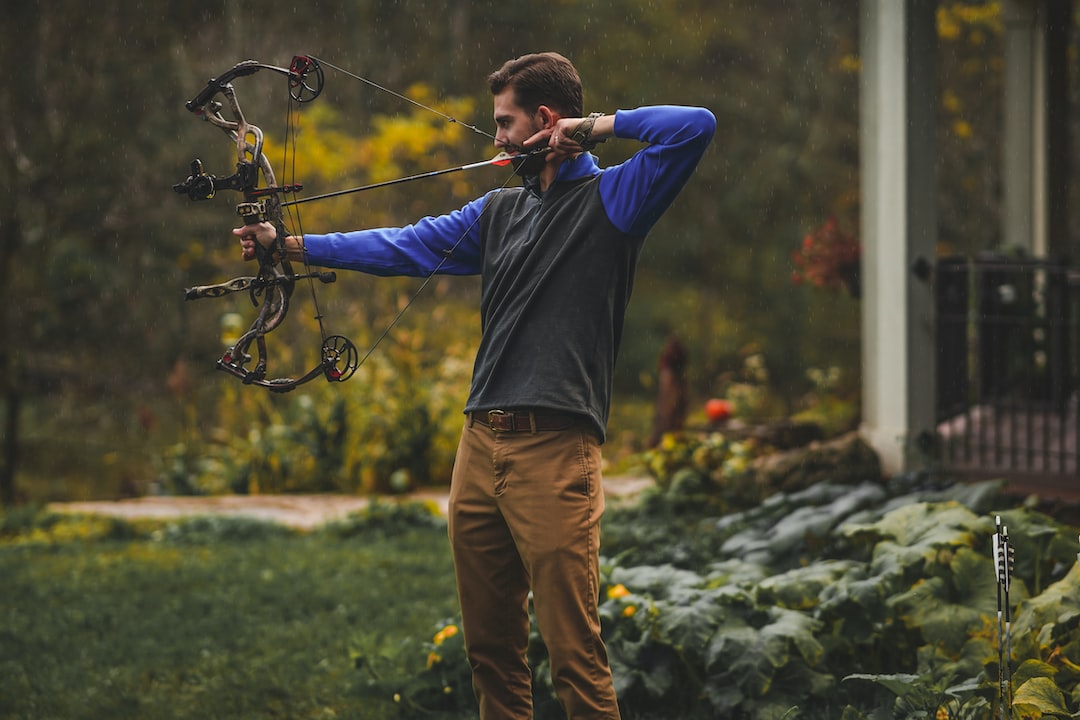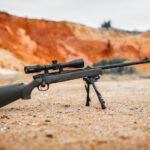Are you ready to take on the challenge of archery hunting for beginners?
If so, you’ve come to the right place. Archery hunting is an incredibly rewarding experience that can provide hours of enjoyment.
Whether you’re a novice or experienced hunter, there are many things to consider when preparing for your first hunt – from selecting the right bow and arrows, setting up your bow properly and learning about different types of releases available.
We’ll also discuss why practicing regularly is essential for successful trips out in nature. Let’s dive into archery hunting for beginners.
Choosing the Right Bow
When it comes to archery hunting, choosing the right bow is essential for success.
The draw weight of a bow determines how much force is required to pull back and release an arrow. A higher draw weight will result in more power behind your shots, but may be too difficult for some shooters to manage.
Selecting the right draw weight can depend on factors such as strength, experience level, and type of game you’re hunting.
Beginners should start with a lower draw weight until they become comfortable shooting with more power.
Compound bows are typically used by most archery hunters due to their superior accuracy and range capabilities compared to recurve bows. Compound bows use pulleys or cams that reduce the amount of effort needed when drawing back the string while also increasing speed and accuracy at longer distances than traditional recurve bows.
Recurve bows are simpler in design than compound models but require greater strength from the shooter when drawing back the string which can limit their range capabilities compared to compounds.
Once you have chosen the right bow for your needs, it is time to set it up and get ready for some archery hunting. This includes attaching the sight and rest, adjusting the draw length and weight, as well as paper tuning your bow.
Setting Up Your Bow
Setting up your bow is an important step in ensuring accuracy and consistency when shooting. It’s essential to make sure the components are properly attached and adjusted for optimal performance.
Attaching the Sight and Rest:
The sight is a crucial part of any archery setup, as it helps you aim accurately at targets or game animals.
Most sights attach to the riser of the bow with screws or bolts, so be sure to follow manufacturer instructions carefully when attaching them.
Once installed, use a bubble leveler to ensure that your sight is perfectly level before tightening down all screws.
After that, attach a rest for stabilizing arrows during release. There are several types available such as drop away rests, whisker biscuit rests, pronged rests and more; choose one based on personal preference and budget considerations.
Adjusting Draw Length and Weight:
Your draw length should be set according to your arm span—measure from fingertip-to-fingertip while standing straight with arms outstretched—and then divide by 2.5 inches (6 cm). This will give you an approximate draw length measurement which can then be fine tuned using paper tuning methods (see below).
Similarly, adjust draw weight by turning limb bolts clockwise until desired poundage is achieved; most bows have markings indicating how many turns each bolt requires for certain poundages so refer to those if needed.
Paper tuning your bow involves shooting arrows through paper targets at close range in order to assess arrow flight patterns after adjusting draw length/weight settings or other variables such as fletching type and angle.
To do this correctly, you’ll need two pieces of paper taped together horizontally forming a ‘V’ shape with about three inches (7 cm) between them at their widest point; shoot three arrows through the gap from ten yards away, noting where they hit relative to each other on either side of the V shape. If they are evenly spaced apart, it indicates good arrow flight stability; otherwise further adjustments may be necessary until satisfactory results are achieved.
By following these steps closely, you can ensure that your bow setup provides consistent accuracy whether hunting game animals or competing in tournaments.
Now that your bow is set up, you’re ready to choose the right arrows for optimal performance.
With a variety of arrow materials, lengths, and weights available on the market today, selecting the perfect match for your bow can be overwhelming – but don’t worry. In our next section we’ll cover everything you need to know about choosing the best arrows for your archery hunting needs.
See more about how to sight in a bow.
Choosing the Right Arrows
The arrow spine, fletching type and material, and length and weight all play a role in how accurate your shots will be. Here’s what you need to know when selecting arrows for hunting.
Matching Arrow Spine to Draw Weight:
When choosing arrows, it’s important to match the arrow spine (the stiffness of the shaft) with the draw weight of your bow. A stiffer arrow will require more energy from a higher draw weight bow than a less stiff one.
Generally speaking, lighter bows should use light-spined arrows while heavier bows should use heavier spines. It’s best to consult with an experienced archer or pro shop when determining which arrow spine is best suited for your setup.
Fletching Types and Materials:
Fletchings are attached at the back end of an arrow shaft and help stabilize its flight path by providing lift as it travels through the air towards its target. There are several types of fletchings available including plastic vanes, feathers, helical vanes, spin wings and others that offer different levels of stabilization depending on their size and shape.
Additionally there are various materials used in making these fletchings such as plastic or rubber compounds or natural feathers like turkey or duck quills that provide different levels of performance depending on their quality level too so be sure to select ones that suit your needs accordingly .
Arrow Lengths & Weights:
Arrows come in various lengths ranging from 18 inches up to 36 inches long but most hunters prefer 24 inch models because they offer good balance between speed & accuracy while still being short enough not get caught up in brushy terrain during hunts if needed.
As far as weights go, most modern carbon fiber arrows weigh around 8 grains per pound (GPP) meaning each inch weighs about 0 .5 GPP so keep this number handy when selecting new ones since you want them light enough for maximum speed without sacrificing stability during flight either.
Finally, make sure you test out any new set ups before heading out into the field since practice makes perfect after all.
Once you have chosen the correct arrows for your draw weight and shooting style, it’s time to look into archery releases – the final step in getting ready for a successful hunt.
Archery Releases Explained
Archery releases are an important tool for any bow hunter or archer. They provide a consistent release of the string, helping to ensure accuracy and consistency in your shots. There are several types of releases available, each with their own pros and cons.
Types of Releases Available:
The most common type of release is the wrist strap release, which consists of a leather or nylon strap that wraps around your wrist and attaches to the bowstring via a trigger mechanism. This type provides good control over the shot but can be uncomfortable if worn for long periods of time.
Another popular option is the handheld mechanical release, which features a handle that you hold onto while pulling back on the string with your other hand. This type offers more control than wrist straps but can be difficult to use accurately due to its size and weight.
Finally, there are thumb-trigger releases which attach directly to your thumb and allow you to pull back on the string without having to grip it tightly with both hands.
Wrist straps offer great control over shots but can cause discomfort after extended use; they also require some practice before using them accurately in hunting situations.
Handheld mechanical releases offer better accuracy than wrist straps but tend to be heavier and bulkier, and may take longer to get used to since they require two hands instead of one when shooting arrows from them.
Thumb-trigger releases provide excellent precision when shooting arrows as well as being lightweight; however, they may not fit all sizes comfortably so make sure you try one out before purchasing it.
Having a good understanding of the different types of archery releases can help you make an informed decision when selecting the right one for your needs. Now that you have this knowledge, let’s move on to the next step: practicing for successful hunting trips.
Practicing for Successful Hunting Trips
Practicing for successful hunting trips is an essential part of any archer’s preparation. Regular practice helps to hone your skills and improve accuracy, which can be the difference between a successful hunt and one that ends in disappointment.
Find a quality hunting target that will withstand hours of practice.
To get the most out of your practice sessions, it’s important to find local archery shops where you can shoot your bow with other experienced hunters.
Finding Local Archery Shops for Setup and Tuning:
There are many benefits to shooting at a range or archery shop rather than practicing on your own. For starters, you have access to expert advice from knowledgeable staff who can help you troubleshoot any issues you may be having with form or technique.
Additionally, there are often target ranges available so that you can simulate real-world conditions and test yourself against various distances and angles before heading out into the field.
Lastly, these locations provide a great opportunity to socialize with other hunters and share tips about gear selection or strategies for success during hunts.
Tips for Improving Accuracy:
In addition to shooting regularly at an archery shop or range, there are several things that every hunter should do in order to maximize their accuracy when they head out into the field.
First off, make sure that all of your equipment is properly tuned before each outing; this includes checking strings and cables as well as making sure sights are properly aligned with arrows being used at the time of shooting.
Secondly, always take some time prior to each shot by taking deep breaths while focusing on proper form; this will help ensure consistency when releasing arrows towards targets downrange.
Finally, consider investing in quality optics such as binoculars or a range finder so that you can accurately gauge distance without having to guess based on visual estimates alone – this could mean the difference between hitting a bullseye versus missing completely.
Take some pointers from the pro’s on Youtube. I like John Dudley and his NockOnArchery channel on YouTube:
FAQs in Relation to Archery Hunting for Beginners
What is the easiest animal to hunt with a bow?
The easiest animal to hunt with a bow is the whitetail deer. Whitetails are relatively easy to spot in their natural habitat, and they have a slower reaction time than other animals when startled. They also are reported to be less skittish than other species, making them easier targets for hunters using bows.
Additionally, due to their size and behavior patterns, it’s possible for archers of all skill levels to successfully take down a whitetail deer with relative ease. With proper preparation and practice, even novice archers can experience success hunting these majestic creatures.
What does a beginner bow hunter need?
A beginner bow hunter needs the right gear and knowledge to ensure a successful hunt. A quality bow, arrows, broadheads, quiver, release aid and sight are essential for accuracy.
Clothing should be comfortable yet durable enough to handle the elements. Proper safety equipment such as a tree stand harness is also important. Finally, it’s important to understand hunting laws and regulations in your area as well as proper animal care techniques.
With these basics in place you’ll be ready for an enjoyable and safe hunting experience.
How long should I practice archery before hunting?
Archery is a skill that requires practice and dedication to master. Depending on your current level of experience, it may take anywhere from a few months to a couple of years of consistent practice before you feel comfortable enough to hunt with archery equipment.
It’s important to focus on developing good form and accuracy while shooting at various distances in order to be successful when hunting.
Start by practicing regularly for an hour or two each day, gradually increasing the distance as your skills improve. If you are hunting big game in a state with mountains, you should prepare by getting in shape for your hunt because the mountains are unforgiving on your body.
With patience and determination, you’ll soon be ready for the hunt.
Is archery hunting hard?
Archery hunting can be challenging, but it is not necessarily hard. It requires practice and skill to become proficient in the sport. You must learn proper form, technique, and safety protocols to ensure a successful hunt.
With dedication and commitment, archers can develop their skills over time and enjoy the thrill of hunting with a bow. The challenge of archery hunting makes it all the more rewarding when you finally make that perfect shot.
Conclusion
Archery hunting for beginners can be a daunting task, but with the right knowledge and gear it doesn’t have to be.
Choosing the right bow, setting up your bow, selecting arrows that are suited for your needs, understanding archery releases and practicing are all key components of becoming an effective hunter. With the proper research and preparation you’ll soon find yourself ready to take on any hunt with confidence.



